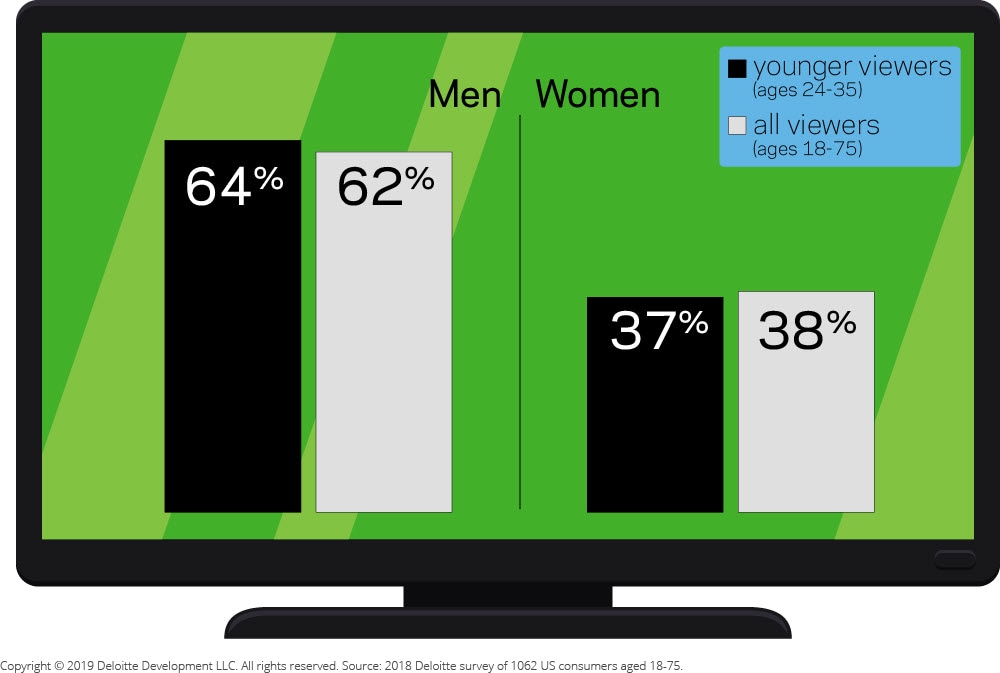Paying to play: The Super Bowl and the power of TV sports to reach younger viewers has been saved

Perspectives
Paying to play: The Super Bowl and the power of TV sports to reach younger viewers
Younger viewers love sports, and advertisers pay big to get in the game
As fragmenting TV audiences reduce opportunities to find key demos, advertisers happy to keep spending more to get into the big game.
Percentage of US TV watchers who watch sports, by age group and gender, 2018
Over 100 million US consumers will watch Super Bowl LIII this Sunday to see which team will win the National Football League’s (NFL) championship game.1 The Super Bowl is also championship time for consumer brands as they compete for the unofficial title of
The Super Bowl is the premier TV sports event in the United States, and advertisers pay handsomely to get in the game. In 2019, a 30-second spot is expected to exceed $5 million for the third consecutive year and will likely deliver around $450 million in ad revenue to the host broadcaster.2
Since 2010, Super Bowl ad costs have risen by a compound annual growth rate (CAGR) of 7 percent, while audiences have declined by 0.4 percent (CAGR). Cost per 1,000 impressions (CPM), a key advertisement spending metric, has increased from $28 to $49 over the same period.3 One might ask whether it’s worth spending more to reach fewer consumers.4
In one sense, the Super Bowl is unique. It attracts twice as many viewers as second most-watched TV program of the year,5 bringing together die-hards, casual fans, and those who love a party. The Super Bowl also proves the power of live sports to reach valuable consumer segments—and why advertisers are paying to play despite escalating costs.
Ratings for the 2019 fall TV season hit a record low, in part because many young viewers are skipping primetime TV.6 Sports programming is more resilient than other TV fare and has unparalleled reach. In 2018, sports programming accounted for 89 of the top 100 most-watched TV broadcasts in the United States.7 Its popularity with younger viewers is a big reason why.
Among TV watchers between the ages of 25 and 34, 64 percent of men and 37 percent of women watch sports. Younger men watch a lot of it: The median 25–34-year-old US male watches sports nearly 17 hours per week.8
Sports programming has helped TV networks maintain contact with younger viewers, but streaming video services are wading in. Amazon streamed 11 NFL contests in 2018 through Prime video and Twitch Prime. A season-high of 2.5 million viewers tuned in for a November game on Prime video, far less than the 21.4 million watching on TV networks. Still, Amazon’s NFL streaming viewership is up 33 percent from 2017.9 Twitch Prime, which broadcasts eSports events and live streams from top players, could help professional sports develop deeper fan engagement.10
TV networks are using their licensing deals with sports leagues to gain subscribers, and head off streaming services. To promote its CBS All Access streaming service, fans can watch the Super Bowl for free on any connected device.11
Expect the games to continue.
This charticle authored by David Ciampa on January 31, 2019.
The stadium experience
Keeping sports fans engaged—and loyal
Nothing can beat a great stadium experience—or can it? Fans at home these days enjoy better camera angles, augmented and virtual reality, and multiplatform, multimedia experiences, ratcheting up pressure on stadiums to deliver an experience the living room can’t match. Luckily, fans are clear about what they want from their stadium experience, and teams that deliver reap the ultimate reward: More loyal, engaged fans.

Endnotes
1 “TV viewership of the Super Bowl in the United States from 1990 to 2018 (in millions),” Statista, February 2018.
2 “Big Game Punting: Super Bowl Scores $5.4 billion in Ad Spending over 52 Years,” AdAge, January 11, 2018.
3 “Huge Playoff Ratings Could Lead to a Super Bowl Audience Boom,” AdAge, January 22, 2019.
4 “Super Bowl LII Slips 7% from 2017 to 103.4 Million Viewers,” Variety, February 5, 2018.
5 “Network TV Can't Survive Without the NFL,” Ad Age, January 3, 2019.
6 “As TV's Fall C3 Ratings Crumble, Feel Free to Blame the Millennials,” Ad Age, November 14, 2018.
7 “Network TV Can't Survive Without the NFL,” Ad Age, January 3, 2019.
8 Eighty percent of US consumers aged 18-75 watch traditional TV—live or time-shifted TV, on Any Device. See “Does TV sports have a future? Bet on it,” Duncan Stewart, Deloitte, December 2018.
9 “Amazon Reveals New Thursday Night Football Streaming Stats, Brings Back First Female NFL Broadcasting Duo,” Geekwire, January 24, 2019.
10 “On your marks, get set, game! eSports and the shape of media in 2019,” Chris Arkenberg, Deloitte, December 2018.
11 “CBS Will Let Everyone Watch Super Bowl 53 Free on Mobile Devices,” bgr.com, September 4, 2018.



